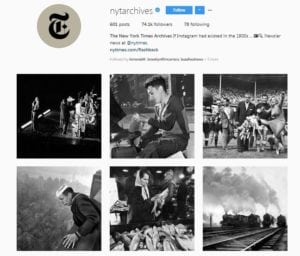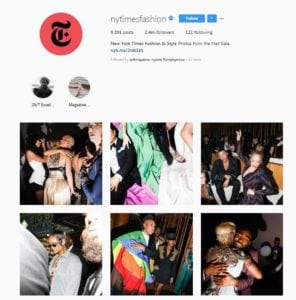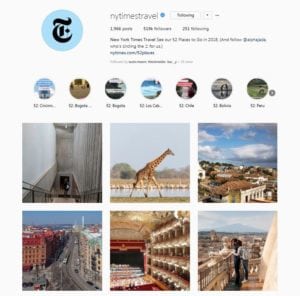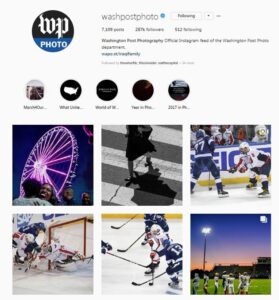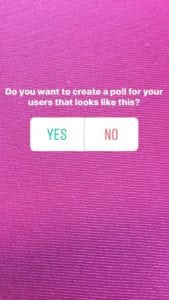
Over the past few years, Instagram has been growing faster than ever. The popular photo-sharing app has added hundreds of millions of users each year since 2014, and that includes news outlets and journalists. But how should the news media be using the platform that truly believes a picture is worth a thousand words? While there are some shortcomings to Instagram (like the inability to share a link within a post, for starters), it’s not as difficult as you might think.
The first and most important step is to decide the purpose of your account. Do you want it to be a way to promote the stories in your print or digital space? Do you want to use it to share behind-the-scenes looks at how your journalists work? Do you want it to be its own standalone platform with its own visual stories?
While you can certainly do a combination of all these things within your account, you should set a primary goal so you can produce the most consistent posts. Consistency is key to promoting your brand and keeping followers interested. If your outlet’s Instagram looks too much like my personal account, you’re going to confuse people about who you are and what it is you’re providing to them.

You also need to know up front that you can’t include links with each image. If you post a link in your photo caption, no one can click it. The exception is the link in your profile bio. Many accounts will include the link to whatever they want to share in their bio, but other than this awkward workaround, it’s best to stick to photos. More on this later.

Now that you know what not to do, it’s time to focus on what you can do.
Share Links — But Do It the Right Way
We talked above about how the only place you can share a clickable link in Instagram is the profile bio. But there are tools you can use to add more links without forcing your followers to log onto a computer to copy and paste, or changing your one link 87 times a day to keep up with what you want to share. To do that, you can create a link to links; one that allows your followers to click your one link and get access to all the links you want to share.
This is especially helpful because Instagram does not sort posts in a user’s feed chronologically, but algorithmically. So, while you might have updated your last link to reflect your latest post, your followers might still be seeing the post from 12 hours earlier telling them to click the “link in bio” to read the full story. Unfortunately for them, however, you’ve already replaced that link, and now they can’t read the story they wanted.
Instead, you can use something like metricool, linktree, LNK.BIO or Link in Profile to share multiple links without having to constantly change the link in your bio and risk confusing followers who are victims of the algorithm.
Another option for sharing links is through Instagram Stories, allowing users to simply swipe up on a post to access the link (and keeping them in Instagram so when they close the article, they’re still right there in your story).
Make Sure Your Posts Reflect Your Brand
If your outlet prides itself on being hard news and serious stories, you don’t want to have an Instagram account full of cute puppies and funny photos of the news. That’s not true to your brand, and you won’t create a crossover audience for either your Instagram or your publication. New platforms can be a great way to get new readers, but not at the expense of your brand identity. People who are interested in what you do will find you.
You can also have more than one Instagram account for your publication, as long as each is true to your overall brand. The Washington Post has more than a half-dozen different accounts, each of which caters to a different kind of user, from general news junkies to sports fans to fans of great photos, illustrations and page designs. The New York Times, too, has several accounts, including those dedicated to fashion, travel and their archival photos.
But you don’t need to be one of the biggest national publications to show off your brand on Instagram. Local newspapers across the country have started Instagram accounts to share their communities with their residents – and the world. While their brands are more streamlined — they focus on their immediate communities and all the people in them — they are no less true to their brands on Instagram.
Use Your Stories
About a year ago, Instagram started allowing users to post Snapchat-style “Stories” to the platform. These Stories are video and photo clips that play on the user’s profile for 24 hours before vanishing. If a story is worthy, you can keep it in your highlights so that anyone who missed it during its initial 24-hour run can come back and watch it whenever they want.
Stories can be anything related to your content, but like your main posts, they should stay on brand. There are so many creative ways to use Stories to share news and information with your followers. Earlier this year, The Guardian created an Instagram story about how their newspapers are printed in order to show off their newly re-designed print product.
The Los Angeles Times recently did an Instagram story where they discussed a very hot topic — the annual National Rifle Association (NRA) convention — with an NRA supporter and YouTube channel host. The story was a perfect fit for the brand because it not only touched on a very hotly-debated news item, but because it found a way to connect to a very L.A.-based industry: YouTube influencers.
Have a Personality
What does it mean to have a personality on Instagram? That depends on you. For example, The Lily, a feminist news product from The Washington Post, has crafted a very stylized Instagram feed that is primarily in black and white with only occasional pops of color. The feed matches the brand’s tone, as The Lily is serious feminist news often presented through a pop culture angle. When you see a Lily post, you know immediately where it’s from and what you can expect if you read the caption or the accompanying story.
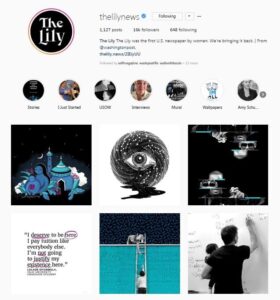
The Atlantic, meanwhile, shares their unique brand of highly-stylized story art on their Instagram page. Traditional photos are few and far between, and are rarely non-styled photos. You won’t see breaking news images in The Atlantic’s feed — that’s not what they’re known for. Instead, you can expect to see intriguing illustrations and captivating headshots of news-makers, all of which are on-brand for the magazine and show their unique take on the news.

Get Creative
While you need to be consistent and stay on brand, you also should be willing to try new things. Social media is all about experimenting and engaging with your audience, and Instagram is no different.
The Washington Post has been using one of their Instagram accounts to introduce followers to members of their staff each week. The account introduces followers to parts of the Post team they might not meet otherwise, from reporters and editors to HR and IT professionals, and gives those staffers full control over the account for the day so they can share what their experiences inside one of the nation’s most famous publications are like.
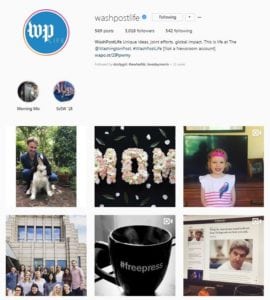
You can also use your Instagram account to engage directly with your followers. You can share their photos of your community on your feed (or exclusively in your Stories if you want to keep your feed consistent and on brand), you can create polls for them within your stories that ask them about the community or — even better — ask them what kind of posts they want to see from you.
Post as Often as You See Fit
There’s no right number of posts on Instagram, and no magic timeframe that works best. Because the algorithm mixes up when people see your posts, you could post 10 times per day or once per day and still have some followers who don’t see your posts, some who see them all at once and others who see them as they’re posted. That said, you don’t want to overwhelm your followers. A few posts per day is fine, but if you want to share more than three or four photos or videos, take it to you story. People can choose to skip through stories more easily, and it feels less intrusive to have constant story updates appearing than a stream of never-ending photos from one poster in your feed.
Think you’ve got it down? If not, below you’ll find examples of news outlets that are using Instagram to share their stories. Maybe their posts will help inspire your newsroom to launch its Instagram account soon, too! In the meantime, send an email to jennifer@newsmediaalliance.org or tweet @EditrixJen and let us know about your ideal newsroom Instagram posts.

